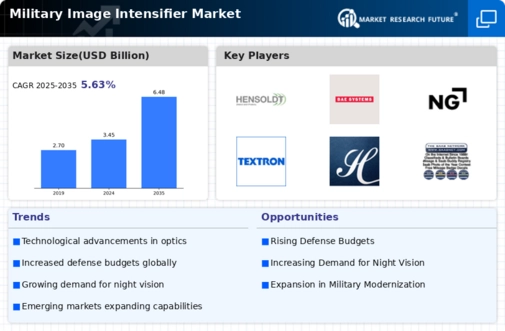Top Industry Leaders in the Military Image Intensifier Market

Strategies Adopted: Key players in the Military Image Intensifier Market employ various strategies to maintain their competitive edge and expand their market presence. These strategies include:
Technological Innovation: Companies invest heavily in research and development to develop advanced image intensification technologies, such as digital image sensors, enhanced signal processing algorithms, and compact, lightweight designs.
Strategic Partnerships and Collaborations: Collaborations with defense agencies, research institutions, and technology partners help companies access new markets, expand their product portfolio, and stay abreast of emerging trends and technologies.
Focus on Customization and Integration: Companies offer customizable solutions tailored to the specific requirements of military end-users, including integration with existing platforms and systems, to enhance interoperability and mission effectiveness.
Global Expansion: Key players focus on expanding their geographical footprint by establishing subsidiaries, manufacturing facilities, and service centers in strategic locations to better serve their customers and capitalize on regional opportunities.
Key Players:
FLIR Systems, Inc. (US)
Harris Corporation (US)
Thales Group (France)
Photonis USA Pennsylvania, Inc. (US)
L3 Technologies, Inc. (US)
Alpha Optics Systems (Canada)
ASELSAN A.Ş. (Turkey)
Photek Limited (UK)
Yukon Advanced Optics Worldwide (Lithuania)
Factors for Market Share Analysis: Several factors contribute to the analysis of market share in the Military Image Intensifier Market, including:
Product Performance and Reliability: The performance, reliability, and durability of image intensification systems play a critical role in determining market share, with companies offering high-quality, mission-critical solutions gaining a competitive advantage.
Technological Differentiation: Companies that differentiate themselves through technological innovation, such as improved resolution, sensitivity, and low-light performance, often capture a larger market share by meeting the evolving needs of military customers.
Customer Relationships: Strong relationships with defense agencies, government organizations, and prime contractors enhance market share by fostering trust, loyalty, and long-term partnerships, leading to repeat business and referrals.
Regulatory Compliance: Compliance with stringent military standards, specifications, and regulations, such as MIL-STD-810 and MIL-PRF-49427, is essential for gaining market share and securing contracts in the defense sector.
New and Emerging Companies: In addition to established players, new and emerging companies are entering the Military Image Intensifier Market, bringing innovative technologies and solutions. These companies often focus on niche segments or disruptive technologies, challenging traditional players and driving innovation in the industry. Some notable new and emerging companies in the market include:
Autoliv Inc.
Aselsan A.S.
Newcon Optik
Yukon Advanced Optics Worldwide
IRay Technology Co., Ltd.
Industry News and Current Company Investment Trends: Recent developments and investment trends in the Military Image Intensifier Market reflect a growing focus on technological advancement, performance optimization, and cost-effective solutions. Key highlights include:
Advancements in Night Vision Technology: Companies are investing in next-generation night vision technologies, such as thermal imaging, multispectral imaging, and fused sensor systems, to enhance situational awareness and battlefield effectiveness.
Integration of Artificial Intelligence: Integration of Artificial Intelligence (AI) and machine learning algorithms enables real-time image enhancement, target recognition, and threat detection, enhancing the capabilities of image intensification systems.
Modular and Upgradable Designs: Companies are developing modular and upgradable image intensifier systems that allow for easy customization, scalability, and future-proofing, enabling military forces to adapt to evolving threats and operational requirements.
Focus on Affordability and Lifecycle Cost: Cost-effective solutions, including reduced lifecycle costs, total ownership costs, and maintenance requirements, are becoming increasingly important for military customers, driving demand for value-driven solutions.
Overall Competitive Scenario: The Military Image Intensifier Market is highly competitive, characterized by technological innovation, strategic partnerships, and stringent regulatory requirements. Established players leverage their experience, expertise, and global presence to maintain market leadership, while new entrants disrupt the market with innovative solutions and agile strategies. As the industry continues to evolve, companies that focus on technological differentiation, customer-centricity, and affordability will thrive in the competitive landscape of the Military Image Intensifier Market.


